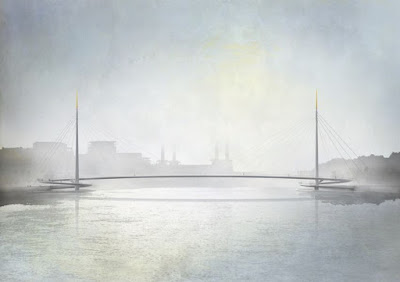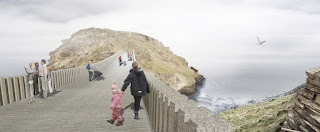The six designs from the shortlisted competitors in English Heritage's £4m
Tintagel Castle bridge design competition have been made public. It's clear that they've brought together a very high calibre of design teams, and the designs are all very interesting.
One of the potential problems with a shortlisted competition is that if any of the entrants come up with a design which is in any way unacceptable, significant effort may be wasted and the promoter's pool of options can be drastically reduced. Many of the designs shown here have significant issues to overcome, and it's not clear to me that any of these designs is entirely fit for purpose.
For more details on the designs, see the
competition website.
Dietmar Feichtinger Architectes / Terrell
I am strangely reminded of the
hallucigenia, a bizarre prehistoric creature which confused many researchers, who initially depicted it upside down. This is something of an upside-down bridge, a steel box-girder installed with a slight upwards arch, and then pulled downwards by a series of stainless steel cables. At first sight, it's as if the bridge is filled with helium and needs to be tied down to prevent it floating away.
The design entry indicates that the cables induce prestress in the bridge deck, although in pure bending terms it is the opposite of a helpful prestress. I can only imagine that the deck is placed into axial compression by virtue of its fixed end points, and this helps counteract normal bending forces. However, it would require a very heavy upper plate to prevent buckling, and has the unfortunate property that the more load is added, the less effective the prestress becomes. I struggle to get my head around the whole idea, and it's not helped by deeply unconvincing cable anchorage details.
The design has a painted steel girder, not ideal for maintenance above such a steep gorge. The parapets are lightweight and open, which will fail to reassure many bridge users, and worse, the deck is an aluminium grille, which will terrify the rest. I find it hard to see how this is an inclusive design suitable for all users, particularly the disabled or infirm.
Marks Barfield Architects / Flint and Neill / J & L Gibbons LLP / Mola
This second design is also a steel box girder bridge, although very different in style. The cross-section is intended to give the impression that the girder is very slender, like the blade of an Arthurian sword, but at heart it's a conventional design, a continuous steel girder on concrete supports.
The supports are "striated" with concrete layers, an hommage to slate and mudstone geology, but are cast as a series of infilled precast shells. This seems a somewhat forced approach, as the precast shell has to be cast in multiple stages only to hide a monolithic core.
The balustrades seem slightly more secure than the previous design, but the most interesting feature of this bridge is that the girders are constructed of roll-bonded structural steel, a material more generally used in cladding and industrial vessels, and which I've not seen used for a bridge like this. Conventional structural steel would be hot-pressed against a phosphor bronze cladding to create a highly corrosion-resistant composite, great for maintenance but at high initial cost. It's an exciting solution, if a little on the unproven side.
Ney and Partners / William Matthews Associates
I think this is both the best presented and the most spectacular entry to the contest. It looks like an arch, but it isn't. Two cantilevers project from either side of the gorge, leaving a tiny gap in the middle. It's highly poetic, yet structurally inefficient compared to a "proper" arch solution.
A slate deck sits on ultra-slender weathering steel plates, slung from the bedrock of Tintagel Castle and propped by weathering steel box girders below. Parapets, and a latticework between the girders, are in stainless steel.
The sense of insecurity inherent in the previous designs is redoubled here by the audacious midspan gap. I wonder how much that gap sways or drops when the bridge is eccentrically loaded by people or wind? The arrangement of the lower arch rib suggests it would be particularly likely to sway in high winds: it's widest at the centre of the span, but that's an arrangement which only makes sense if there's no gap.
All structural elements look impossibly slender at first sight, but I suspect they are not entirely implausible, with the latticework stiffening the lower "arch" box girder against buckling. The real problem with this design is the materials, as connecting stainless steel directly to weathering steel can induce corrosion in the latter, and even at this height, I suspect airborne salt spray would cause serious corrosion to the bridge over time.
Niall McLaughlin Architects / Price and Myers
Here's another design with an interesting use of materials, with a bronze balustrade upon a highly unusual prestressed granite bridge deck.
Prestressed granite is not a new concept: there have been quite a few bridges built in this way at a small scale, but not at the span proposed here. A larger bridge was proposed by German designer Heinz Hossdorf, but never built. The design here owes a debt both to Hossdorf and to Jurg Conzett. It would be built be cantilevering thin granite slices outwards from the supports, assisted by temporary cable support.
It would be an extremely durable solution, but the sheer weight of materials would render the construction phase expensive, certainly compared to some of the other designs. And, as with every design so far, the balustrade design may leave many users feeling exposed.
RFR / Jean Francois Blassel Architecte / EngineersHRW / WSP Parsons Brinckerhoff
Here we have a second granite arch, although of more conventional design - a "traditional" masonry arch bridge, rather than a prestressed structure. Only the arch barrel is granite: the spandrel walls are of an unspecified stone, as are the balusters, which are a series of stone ribs with small gaps between them. The arch backing is a mix of foamed concrete with void formers, the latter to reduce weight.
The bridge would be erected on temporary centering, a very expensive business. The arch has a very low rise for a masonry arch, rendering it highly vulnerable to any ground movement, but there are few locations with such rocky ground to rely upon. The use of materials is inefficient, but if it works structurally, it's the most durable of all the solutions put forward.
I like the fact that the balusters provide a degree of physical and visual shelter, it's the only design which seems to me to really consider the experience of all possible visitors. However, I dislike its visual heaviness, particularly at the mainland end, where as well as being much deeper, the structure is also much wider. There could be considerable cost involved in stabilising the supporting rock slopes.
Wilkinson Eyre / Atelier One
The final design is in some ways the boldest proposal, an uncompromisingly modern structure, all high-tech and angular. It's a lightweight cable truss, with stainless steel struts and ties, and a composite deck comprised of oak and stainless steel elements. The composite construction renders the oak elements of the deck impossible to replace, so we'd have to hope they last as long as the rest of the bridge.
The bridge would be erected either on a scaffold or assembled from a temporary cable framework. The form of the bridge is such that is not functional until it is complete, hence the significant temporary works.
The bridge's main engineering challenge will be to ensure it is stable under pedestrian and wind loading. I wonder whether a less angular structure could have been attempted, and as with most of the designs, I think many users would feel insecure.
For me, none of these designs is the obvious winner, they are all flawed in different ways, and it's a case of choosing the least flawed option. I'd vote for the Ney design on sheer good looks, but would favour the Price & Myers design if it had a more sheltering parapet. It will be very interesting to see who wins, due to be announced in February.







































